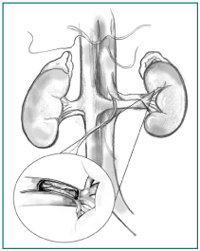Renal artery stenosis pathophysiology
|
Renal artery stenosis Microchapters |
|
Diagnosis |
|---|
|
Treatment |
|
Case Studies |
|
Renal artery stenosis pathophysiology On the Web |
|
American Roentgen Ray Society Images of Renal artery stenosis pathophysiology |
|
Risk calculators and risk factors for Renal artery stenosis pathophysiology |
Editor-In-Chief: C. Michael Gibson, M.S., M.D. [1] Associate Editor(s)-in-Chief: Shivam Singla, M.D.[2]
Overview
The reduction in renal blood flow secondary to renal artery stenosis stimulates renin release from the juxtaglomerular apparatus through activation of the tubuloglomerular feedback, baroreceptor reflex, and the sympathetic nervous system. Elevated angiotensin II activities in turn cause elevation of the arterial pressure and other effects including aldosterone secretion, sodium retention, and left ventricular hypertrophy and remodeling.[1]
Pathophysiology
Renal artery stenosis means the narrowing of both renal arteries leading to the obstruction of blood flow and resulting in the stimulation of RAAS. The blood flow to the kidneys is generally greater than perfusion to any other organ and the GFR mainly depends on the glomerular capillary hydrostatic pressure. In patients with RAS, the reduced blood flow to the kidneys leads to the formation of collateral blood vessels and increases secretion of renin by juxtaglomerular apparatus and activation of the renin-angiotensin-aldosterone system. Renin converts angiotensinogen to angiotensin I and then with the help of the enzyme ACE that is an angiotensin-converting enzyme it further gets converted to angiotensin II. This angiotensin II directly causes vasoconstriction and also increases aldosterone which results in the retention of sodium and water thus leads to the development of renovascular hypertension that is also called secondary hypertension. Prolonged hypoperfusion to the kidneys resulting in chronic stimulation and hyperplasia of the juxtaglomerular apparatus. This prolonged ischemia further leads to renal insufficiency and inturn progressive renal atrophy.
Pathogenesis of Chronic Renal Insufficiency
Glomerular filtration rate (GFR) is autoregulated with the help of angiotensin II and numerous other modulators. The GFR gets affected when the renal perfusion drops below 70mmhg. the apparent change in GFR is observed once the arterial lumen narrows by more than 50%. Numerous studies reported that GFR is reduced when altogether there is a reduction in renal perfusion pressure by more than 40% and a reduction in mean renal blood flow by 30%. However, even after this the kidneys cortex and medulla can adapt without the development of severe hypoxia. So early disease can be managed with the medical approach and that can prevent the development of progressive function loss and fibrosis.But in cases with more significant stenosis around 70-80%, there is the development of apparent cortical hypoxia and this hypoxia further leads to the rarefaction of microvessels and ultimately leads to the development of interstitial fibrosis. Therefore the loss of renal function and progressive renal disease. Eventually, it becomes irreversible and restoration of blood flow to the kidneys will not help in getting back the kidney functions.
